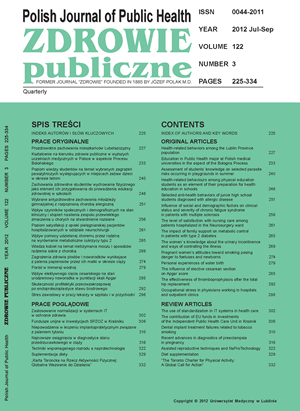Personal experiences of water birth
Keywords:
water immersion, water birth, vaginal birthAbstract
Introduction. Water birth is one of the advanced methods of labour managing.
Aim. The aim of this study is the assessment of the influence of water immersion on labour progress, condition of mother and newborn as well as the women’s reported contentment with childbirth.
Material and methods. An anonymous survey of own design was used for the research. The gathered material was statistically analyzed using Satistica and Excel software. The research was conducted from October 2009 till March 2010 on 74 randomly chosen women, giving birth at The Regional Specialist Hospital in Wrocław.
Results. The preparations for a traditional birth were carried out by the attending physician at the clinic (49%), while the ones for the water birth, by a midwife at a birth center (51%). In both groups the father was present in 86% of the cases. Seventy three per cent delivered during the first or second immersion. No instrumental procedures were required during the whole process of water birth and lower pain levels in comparison to the traditional method were reported. The water could have decreased the intensity of contractions and slowed the labor. The first stage of labor was reported as short by women who chose the water method (46%), while the second stage was reported as a long one by the same group of women (14%) and as a very long by women who chose the traditional method (5%). Compared to the traditional birth, episiotomy rates for a water birth are distinctively lower, as well as sex organ injuries – 27% in the former and 8% in the latter. There is no difference in the rate of complications in the third stage of labor between the test group and the control group. Compared to the control group no increase in perinatal bleeding was observed in the test group.
Conclusions. After meeting adequate conditions water birth can serve as an alternative to traditional obstetrics.
References
1. Agrawal P. Odkrywam macierzyństwo. Wrocław: GS Media; 2007.
2. Grodzka M, Makowska P, Wielgoś M, et al. Poród w wodzie w ocenie rodzących kobiet. Gin Pol. 2001;72(12):1025-9.
3. Mackay M. Use of water in labor and birth. Clin Obst Gyn. 2001;44:733-49.
4. Moneta J, Okińska A, Wielgoś M, et al. Wpływ immersji wodnej na przebieg porodu. Gin Pol. 2001;72(12):1031-6.
5. Zimmermann R, Huch A, Huch R. Water birth – is safe? J Perinat Mad. 1993;21:5-11.
6. Laudański T. Hydroterapia w perinatologii. Klin Perin Gin. 2002; (suppl. 25):77-83.
7. Guzikowski W. Immersja wodna w czasie porodu i poród w wodzie. Fam Med Prim Care Rev. 2009;11(2):163-7.
8. Laudański T. Immersja wodna w porodzie i poród w wodzie. Klin Perin Gin. 1996;(suppl. 13):76-80.
9. Kornacka M. Wpływ bliskiego kontaktu (skóra do skóry) dziecka z matką krótko po porodzie na późniejsze zachowanie noworodka. Med Prakt Pediat. 2004;06:69-71.
10. Thöni A, Sioma-Markowska U. Poród w wodzie – doświadczenia z oddziału położniczego w Vipiteno we Włoszech. Klin Perin i Gin. 2007;43(2):61-5.
11. Sipiński A., Poręba R., Cnota W, Poręba A. Analiza 135 porodów w wodzie. Gin Pol. 2000;71(4):208-12.
12. Roberts J, Hanson L. Best practices in second stage labor care: Maternal bearing down and positioning. JMWH. 2007;52(3):238-45.
13. Thomson AM. Pushing techniques in the second stage of labour. J Adv Nurs. 1993;18(2):171-7.
14. Cammu H, Classen K, Van Wattern J. Is having a warm bath during labor useful? J Perinat Med. 1992;20:104.


